| Revision as of 05:57, 17 July 2010 editSven70 (talk | contribs)594 editsNo edit summary← Previous edit | Revision as of 06:41, 17 July 2010 edit undoSven70 (talk | contribs)594 edits →GeographyNext edit → | ||
| Line 153: | Line 153: | ||
| == Geography == | == Geography == | ||
| ] | |||
| ] | ] | ||
| New Guinea lies north of ]'s ], ] and ], separated by the ] to the west and the ] and ] to the east. It further is located east of ], west of the ] and ], and south of ] and the ]. | |||
| A central east-west mountain range dominates the geography of New Guinea, over 1600 km in total length. The ] of the island of New Guinea contains the highest mountains in Oceania, rising up to 4884 m high, and ensuring a steady supply of rain from the equatorial atmosphere. The tree line is around 4000 m elevation and the tallest peaks contain permanent equatorial ]s — which have been retreating since at least 1936 <ref>Prentice, M.L. and G.S. Hope (2006). "Climate of Papua". Ch. 2.3 in Marshall, A.J., and Beehler, B.M. (eds.). The Ecology of Papua. Singapore: Periplus Editions. ''The authors note that "The magnitude of the recession of the Carstenz Glaciers, it's causes, and its implications for local, regional, and global climate change are only qualitatively known."''</ref><ref>[http://www.easternsnow.org/proceedings/2004/kincaid_and_klein.pdf Kincaid and Kline, "Retreat of the Irian Jaya Glaciers from 2000 to 2002 | A central east-west mountain range dominates the geography of New Guinea, over 1600 km in total length. The ] of the island of New Guinea contains the highest mountains in Oceania, rising up to 4884 m high, and ensuring a steady supply of rain from the equatorial atmosphere. The tree line is around 4000 m elevation and the tallest peaks contain permanent equatorial ]s — which have been retreating since at least 1936 <ref>Prentice, M.L. and G.S. Hope (2006). "Climate of Papua". Ch. 2.3 in Marshall, A.J., and Beehler, B.M. (eds.). The Ecology of Papua. Singapore: Periplus Editions. ''The authors note that "The magnitude of the recession of the Carstenz Glaciers, it's causes, and its implications for local, regional, and global climate change are only qualitatively known."''</ref><ref>[http://www.easternsnow.org/proceedings/2004/kincaid_and_klein.pdf Kincaid and Kline, "Retreat of the Irian Jaya Glaciers from 2000 to 2002 | ||
| Line 167: | Line 169: | ||
| Another major habitat feature is the vast southern and northern lowlands. Stretching for hundreds of kilometres, these include lowland ]s, extensive wetlands, ] grasslands, and some of the largest expanses of ] forest in the world. The southern lowlands are the site of ], also a ] ]. | Another major habitat feature is the vast southern and northern lowlands. Stretching for hundreds of kilometres, these include lowland ]s, extensive wetlands, ] grasslands, and some of the largest expanses of ] forest in the world. The southern lowlands are the site of ], also a ] ]. | ||
| The ], ], ], and ] rivers are the island's major river systems that drain in roughly northeast, northwest, southeast, and southwest directions respectively. Many of these rivers have broad areas of meander and result in large areas of |
The ], ], ], and ] rivers are the island's major river systems that drain in roughly northeast, northwest, southeast, and southwest directions respectively. Many of these rivers have broad areas of meander and result in large areas of ]s and freshwater swamps. | ||
| New Guinea contains many of the world’s ecosystem types: glacial, alpine tundra, savanna, montane and lowland rainforest, |
New Guinea contains many of the world’s ecosystem types: glacial, ], ], ] and ], ]s, ]s, lake and ]s, ]es, and some of the richest ]s on the planet. | ||
| == References == | == References == | ||
Revision as of 06:41, 17 July 2010
| Geography | |
|---|---|
| Location | Melanesia |
| Coordinates | 5°20′S 141°36′E / 5.333°S 141.600°E / -5.333; 141.600 |
| Area rank | 2nd |
| Administration | |
| Indonesia | |
| Demographics | |
| Population | ~ 7.5 million |
| Pop. density | 8/km (21/sq mi) |
| This article's lead section may be too short to adequately summarize the key points. Please consider expanding the lead to provide an accessible overview of all important aspects of the article. |
New Guinea, the largest island in the Indonesian archipelago, and located in Melanesia immediately north of northeast Australia in the Southwest Pacific, is the world's second largest island with its 786,000 sq km. It has a low population density (8 inh/sq km) with its 7.5 million people. Its highest mount is the Puncak Jaya at an elevation of 4,884 m (16,023 ft). It became separated from Australia when the area now known as the Torres Strait flooded after the last glacial period, sundering the continent of Sahul. The western half of the island is known as West Papua and contains two Indonesian provinces, while the eastern half forms the mainland of the independent country of Papua New Guinea.
Political divisions
The island of New Guinea is divided politically into roughly equal halves across a north-south line:
- The western portion of the island located west of 141°E longitude, (except for a small section of territory to the east of the Fly River which belongs to Papua New Guinea) was formerly a Dutch colony and is now incorporated into Indonesia as the provinces:
- West Papua with Manokwari as its capital.
- Papua with the city of Jayapura as its capital. A proposal to split this province into Central Papua (Papua Tengah) and East Papua (Papua Timur) has not been implemented.
- (See also West Papua (region), which refers to the entire western half of New Guinea)
- The eastern part forms the mainland of Papua New Guinea, which has been an independent country since 1975. It was formerly a territory governed by Australia, consisting of the Trust Territory of New Guinea (formerly German New Guinea) and the Territory of Papua. The country consists of four regions:
- Papua, consisting of Western, Gulf, Central, Oro (Northern) and Milne Bay provinces.
- Highlands, consisting of Southern Highlands, Enga Province, Western Highlands, Simbu and Eastern Highlands provinces.
- Momase, consisting of Morobe, Madang, East Sepik and Sandaun (West Sepik) provinces.
- Islands, consisting of Manus, West New Britain, East New Britain and New Ireland provinces, and the Bougainville Autonomous Province.
Each province has an administration headed by a governor who is also a member of the national parliament.
People

The current population of the island of New Guinea is about 7.1 million people. Many believe human habitation on the island has been dated to as early as approximately 40,000 B.C., and first settlement possibly dated back to 60,000 years ago has been proposed. The island is presently populated by very nearly a thousand different tribal groups and a near-equivalent number of separate languages, which makes New Guinea the most linguistically diverse area in the world. Ethnologue 14th edition lists 826 languages of Papua New Guinea and 257 languages of Irian Jaya, total 1073 languages, with 12 languages overlapping. They fall into one of two groups, the Papuan languages and the Austronesian languages. The separation was not merely linguistic; warfare among societies was a factor in the evolution of the men's house: separate housing of groups of adult men, from the single-family houses of the women and children, for mutual protection against the other groups. Pig-based trade between the groups and pig-based feasts are a common theme with the other peoples of southeast Asia and Oceania. Most societies practice agriculture, supplemented by hunting and gathering.
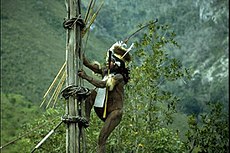
The great variety of the island's indigenous populations are frequently assigned to one of two main ethnological divisions, based on archaeological, linguistic and genetic evidence: the Papuan and Austronesian groups.
Current evidence indicates that the Papuans (who constitute the majority of the island's peoples) are descended from the earliest human inhabitants of New Guinea. These original inhabitants first arrived in New Guinea at a time (either side of the Last Glacial Maximum, approx 21,000 years ago) when the island was connected to the Australian continent via a land bridge, forming the landmass known as Sahul. These peoples had made the (shortened) sea-crossing from the islands of Wallacea and Sundaland (the present Malay Archipelago) by at least 40,000 years ago, subsequent to the dispersal of peoples from Africa (circa) 50,000 - 70,000 years ago.
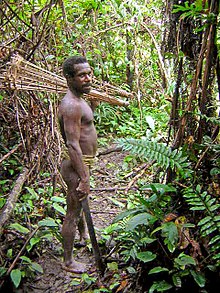
The ancestral Austronesian peoples are believed to have arrived considerably later, approximately 3,500 years ago, as part of a gradual seafaring migration from Southeast Asia, possibly originating in eastern China. Austronesian-speaking peoples colonized many of the offshore islands to the north and east of New Guinea, such as New Ireland and New Britain, with settlements also on the coastal fringes of the main island in places.
Human habitation of New Guinea over tens of thousands of years has led to a great deal of diversity, which was further increased by the later arrival of the Austronesians and the more recent history of European and Asian colonization. This process has been accelerated by the transmigration programs and conscious policies enacted by successive Indonesian governments, which over recent decades has encouraged the resettlement of as many as one million immigrants to western New Guinea, predominantly from the islands of Java, Madura, and Bali.
Large swathes of New Guinea are yet to be explored by scientists and anthropologists. The province of Irian Jaya or West Papua is home to an estimated 44 uncontacted tribal groups.
Biodiversity and ecology
Main article: Fauna of New GuineaWith some 786,000 km² of tropical land — less than one-half of one percent (0.5%) of the Earth's surface — New Guinea has an immense ecological value in terms of biodiversity, with between 5 to 10% of the total species on the planet. This percentage is about the same amount as the United States or Australia. A high percentage of New Guinea's species are endemic (found nowhere else), and thousands are still unknown to science: probably well over 200,000 species of insect, between 11,000 to 20,000 plant species; over 650 resident bird species, including most species of birds of paradise and bowerbirds, parrots, and cassowaries; over 400 amphibians; 455 butterfly species; marsupials and monotremes including Bondegezou, Goodfellow's Tree-kangaroo, Huon Tree-kangaroo, Long-beaked Echidna, Tenkile, Agile Wallaby, Alpine Wallaby, cuscuses and possums; and various other mammal species. Most of these species are shared, at least in their origin, with the continent of Australia, which was until fairly recent geological times, part of the same landmass (see Australia-New Guinea for an overview). The island is so large that it is considered 'nearly a continent' in terms of its biological distinctiveness.
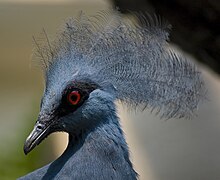
Biogeographically, New Guinea is part of Australasia rather than the Indomalayan realm, although New Guinea's flora has many more affinities with Asia than its fauna, which is overwhelmingly Australian. Botanically, New Guinea considered part of Malesia, a floristic region that extends from the Malay Peninsula across Indonesia to New Guinea and the East Melanesian Islands. The flora of New Guinea is a mixture of many tropical rainforest species with origins in Asia, together with typically Australasian flora. Typical southern hemisphere flora include the conifers Podocarpus and the rainforest emergents Araucaria and Agathis, as well as tree ferns and several species of Eucalyptus.
New Guinea has 284 species and six orders of mammals: (monotremes, three orders of marsupials, rodents and bats); 195 of the mammal species (69%) are endemic. New Guinea has 578 species of breeding birds, of which 324 species are endemic. The island's frogs are one of the most poorly known vertebrate groups, currently totalling 282 species, but this number is expected to double or even triple when all species have been documented. New Guinea has a rich diversity of coral life and 1,200 species of fish have been found. Also about 600 species of reef-building coral — the latter equal to 75 percent of the world’s known total. The entire coral area covers 18 million hectares off a peninsula in northwest New Guinea.
Ecoregions
Terrestrial
According to the WWF, New Guinea can be divided into twelve terrestrial ecoregions:
- Central Range montane rain forests
- Central Range sub-alpine grasslands
- Huon Peninsula montane rain forests
- New Guinea mangroves
- Northern New Guinea lowland rain and freshwater swamp forests
- Northern New Guinea montane rain forests
- Southeastern Papuan rain forests
- Southern New Guinea freshwater swamp forests
- Southern New Guinea lowland rain forests
- Trans Fly savanna and grasslands
- Vogelkop montane rain forests
- Vogelkop-Aru lowland rain forests
Freshwater
The WWF and Nature Conservancy divide New Guinea into five freshwater ecoregions:
- Vogelkop–Bomberai
- New Guinea North Coast
- New Guinea Central Mountains
- Southwest New Guinea–Trans-Fly Lowland
- Papuan Peninsula
Marine
The WWF and Nature Conservancy identify several marine ecoregions in the seas bordering New Guinea:
- Papua
- Bismarck Sea
- Solomon Sea
- Southeast Papua New Guinea
- Gulf of Papua
- Arafura Sea
History
See also: History of Papua New GuineaThe first inhabitants of New Guinea arrived at least around 40,000 years ago, having travelled through the south-east Asian peninsula. These first inhabitants, from whom the Papuan people are probably descended, adapted to the range of ecologies and in time developed one of the earliest known agricultures. Remains of this agricultural system, in the form of ancient irrigation systems in the highlands of Papua New Guinea, are being studied by archaeologists. This work is still in its early stages so there is still uncertainty as to precisely what crop was being grown, or when/where agriculture arose. Sugar cane was cultivated for the first time in New Guinea around 6000 B.C.
The gardens of the New Guinea Highlands are ancient, intensive permacultures, adapted to high population densities, very high rainfalls (as high as 10,000 mm/yr (400 in/yr)), earthquakes, hilly land, and occasional frost. Complex mulches, crop rotations and tillages are used in rotation on terraces with complex irrigation systems. Western agronomists still do not understand all practices, and it has been noted that native gardeners are as or more successful than most scientific farmers in raising certain crops. There is evidence that New Guinea gardeners invented crop rotation well before western Europeans. A unique feature of New Guinea permaculture is the silviculture of Casuarina oligodon, a tall, sturdy native ironwood tree, suited to use for timber and fuel, with root nodules that fix nitrogen. Pollen studies show that it was adopted during an ancient period of extreme deforestation.
In more recent millennia another wave of people arrived on the shores of New Guinea. These were the Austronesian people, who had spread down from Taiwan, through the south-east Asian archipelago, colonising many of the islands on the way. The Austronesian people had technology and skills extremely well adapted to ocean voyaging and Austronesian language speaking people are present along much of the coastal areas and islands of New Guinea.
The first European contact with New Guinea was by Portuguese and/or Spanish sailors in the 16th century. In 1526-27 the Portuguese explorer Jorge de Meneses saw the western tip of New Guinea and named it ilhas dos Papuas. Ploeg reports that the word papua is often said to derive from the Malay word papua or pua-pua, meaning 'frizzly-haired', referring to the highly curly hair of the inhabitants of these areas. Another possibility, (put forward by Sollewijn Gelpke in 1993) is that it comes from the Biak phrase sup i papwa which means 'the land below ' and refers to the islands west of the Bird's Head, as far as Halmahera.
Whatever the origin of the name Papua, it came to be associated with this area, and more especially with Halmahera, which was known to the Portuguese by this name during the era of their colonisation in this part of the world.
In 1545 the Spaniard Yñigo Ortiz de Retez sailed along the north coast of New Guinea as far as the Mamberamo River near which he landed, naming the island 'Nueva Guinea'. The first map showing the whole island (as an island) was published in 1600 and shows it as 'Nova Guinea'.
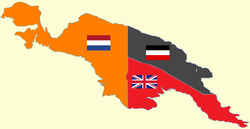
The first European claim occurred in 1828, when the Netherlands formally claimed the western half of the island as Netherlands New Guinea. In 1883, following a short-lived French annexation of New Ireland, the British colony of Queensland annexed south-eastern New Guinea. However, the Queensland government's superiors in the United Kingdom revoked the claim, and (formally) assumed direct responsibility in 1884, when Germany claimed north-eastern New Guinea as the protectorate of German New Guinea (also styled Kaiser-Wilhelmsland). The first Dutch government posts were established in 1898 and in 1902 Manokwari on the North coast, Fak-Fak in the West and Merauke in the South at the border with British New Guinea.
Germans, Dutch and the British tried to suppress warfare and headhunting once common between the villages of the populace.
In 1905 the British government renamed their territory as the Territory of Papua, and in 1906 transferred total responsibility for it to Australia. During World War I, Australian forces seized German New Guinea, which in 1920 became the Territory of New Guinea, a League of Nations mandated territory of Australia. The Australian territories became collectively known as The Territories of Papua and New Guinea (until February 1942).

Before about 1930, most European maps showed the highlands as uninhabited forests. When first flown over by aircraft, numerous settlements with agricultural terraces and stockades were observed. The most startling discovery took place on 4 August 1938, when Richard Archbold discovered the Grand Valley of the Baliem River which had 50,000 yet-undiscovered Stone Age farmers living in orderly villages. The people, known as the Dani, were the last society of its size to make first contact with the rest of the world.
Netherlands New Guinea and the Australian territories were invaded in 1942 by the Japanese. The Australian territories were put under military administration and were known simply as New Guinea. The highlands, northern and eastern parts of the island became key battlefields in the South West Pacific Theatre of World War II. Papuans often gave vital assistance to the Allies, fighting alongside Australian troops, and carrying equipment and injured men across New Guinea. Following the return to civil administration, the Australian section was known as the Territory of Papua-New Guinea (1945-49) and then as Papua and New Guinea. Although the rest of the Dutch East Indies achieved independence as Indonesia on 27 December 1949, the Netherlands regained control of western New Guinea.
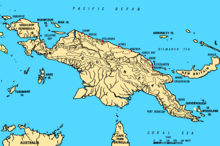
During the 1950s the Dutch government began to prepare Netherlands New Guinea for full independence and allowed elections in 1959; an elected Papuan council, the New Guinea Council (Nieuw Guinea Raad) took office on 5 April 1961. The Council decided on the name of West Papua, a national emblem, a flag called the Morning Star or Bintang Kejora, and a national anthem; the flag was first raised — next to the Dutch flag — on 1 December 1961. However, Indonesia threatened with an invasion, after full mobilisation of its army, by 15 August 1962, after receiving military help from the Soviet Union. Under strong pressure of the United States government (under the Kennedy administration) the Dutch, who were prepared to resist an Indonesian attack, attended diplomatic talks. On 1 October 1962, the Dutch handed over the territory to a temporary UN administration (UNTEA). On 1 May 1963, Indonesia took control. The territory was renamed West Irian and then Irian Jaya. In 1969 Indonesia, under the 1962 New York Agreement, was required to organise a plebiscite to seek the consent of the Papuans for Indonesian rule. This so called Act of Free Choice (Pepera) resulted, under strong threats and intimidations of the Indonesian military, in a 100% vote for continued Indonesian rule.
There has been resistance to Indonesian integration and occupation, both through civil disobedience (such as Morning Star flag raising ceremonies) and via the formation of the Organisasi Papua Merdeka (OPM, or Free Papua Movement) in 1965. Amnesty International has estimated more than 100,000 Papuans, one-sixth of the population, have died as a result of government-sponsored violence against West Papuans, while others had previously specified much higher death tolls.
From 1971, the name Papua New Guinea was used for the Australian territory. On 16 September 1975, Australia granted full independence to Papua New Guinea.
In 2000, Irian Jaya was formally renamed "The Province of Papua" and a large measure of "special autonomy" was granted in 2001. This law on special autonomy, however, was never implemented. On the contrary, at the beginning of 2003 President Megawati Sukarnoputri announced the division of the province into three parts, while the name "Papua" for the province would again revert to Irian. With strong public protest by Papuans, the matter was referred to the Indonesian courts, who declared it to be unconstitutional and in contravention of the Papua's special autonomy agreement. By that point though, the western part had already been administratively separated from the rest and the central and eastern parts were almost separated. The court blocked the second separation on the grounds listed above but the previous division into two provinces was allowed to stand as an established fact. (King, 2004, p. 91) The western part became the province of West Irian Jaya, with Manokwari as its capital and covering the Bird's Head Peninsula. In 2005 a new proposal came from Jakarta to split the province into five provinces. This plan has not yet been implemented.
Geography

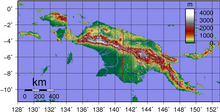
New Guinea lies north of Australia's Top End, Gulf of Carpentaria and Cape York peninsula, separated by the Arafura Sea to the west and the Torres Strait and Coral Sea to the east. It further is located east of Indonesia, west of the Bismarcks and Solomons, and south of Palau and the Federated States of Micronesia.
A central east-west mountain range dominates the geography of New Guinea, over 1600 km in total length. The western half of the island of New Guinea contains the highest mountains in Oceania, rising up to 4884 m high, and ensuring a steady supply of rain from the equatorial atmosphere. The tree line is around 4000 m elevation and the tallest peaks contain permanent equatorial glaciers — which have been retreating since at least 1936 . Various other smaller mountain ranges occur both north and west of the central ranges. Except in high elevations, most areas possess a warm humid climate throughout the year, with some seasonal variation associated with the northeast monsoon season.
The Highest Peaks on the Island of New Guinea are:
- Puncak Jaya, sometimes known by its former Dutch name Carstensz Pyramid, is a mist covered limestone mountain peak on the Indonesian side of the border. At 4,884 metres (16,023 ft), Puncak Jaya makes New Guinea the world's fourth highest landmass.
- Puncak Trikora also in Papua is 4,750 metres (15,584 ft).
- Mount Wilhelm is the highest peak on the PNG side of the border at 4,509 metres. Its granite peak is the highest point of the Bismarck Range.
- Mount Giluwe 4,368 metres is the second highest summit in PNG it is also the highest volcanic peak in Oceania.
Another major habitat feature is the vast southern and northern lowlands. Stretching for hundreds of kilometres, these include lowland rainforests, extensive wetlands, savanna grasslands, and some of the largest expanses of mangrove forest in the world. The southern lowlands are the site of Lorentz National Park, also a UNESCO World Heritage Site.
The Sepik, Mamberamo, Fly, and Digul rivers are the island's major river systems that drain in roughly northeast, northwest, southeast, and southwest directions respectively. Many of these rivers have broad areas of meander and result in large areas of lakes and freshwater swamps.
New Guinea contains many of the world’s ecosystem types: glacial, alpine tundra, savanna, wikt:montane and lowland rainforest, mangroves, wetlands, lake and river ecosystems, seagrasses, and some of the richest coral reefs on the planet.
References
- Groube, Chappell, et al., Letter to Nature Dec 1986
- Encyclopædia Britannica Online
- First contact with isolated tribes?
- Wikramanayake, Eric; Eric Dinerstein; Colby J. Loucks; et al. (2002). Terrestrial Ecoregions of the Indo-Pacific: a Conservation Assessment. Island Press; Washington, DC
- Abell, Robin, Michele L. Thieme, et al. (2008). "Freshwater Ecoregions of the World: A New Map of Biogeographic Units for Freshwater Biodiversity Conservation". Bioscience" May 2008 / Vol. 58 No. 5, pgs. 403-414
- Spalding, Mark D., Helen E. Fox, Gerald R. Allen, Nick Davidson et al. "Marine Ecoregions of the World: A Bioregionalization of Coastal and Shelf Areas". Bioscience Vol. 57 No. 7, July/August 2007, pp. 573-583.
- http://www.plantcultures.org/plants/sugar_cane_history_early_origins_and_spread.html
- Diamond, Jared. Collapse. (German translation), Frankfurt 2005, p. 350.
- Diamond, Jared. Collapse. (German translation), Frankfurt 2005, p. 351.
- Ploeg, Anton. 2002. '"De Papoea" What's in a name?'. The Asia Pacific Journal of Anthropology 3(1), pp.75-101
- Diamond, Jared. The Third Chimpanzee. Harper Collins, 1993
- Report claims secret genocide in Indonesia - University of Sydney
- West Papua Support
- Prentice, M.L. and G.S. Hope (2006). "Climate of Papua". Ch. 2.3 in Marshall, A.J., and Beehler, B.M. (eds.). The Ecology of Papua. Singapore: Periplus Editions. The authors note that "The magnitude of the recession of the Carstenz Glaciers, it's causes, and its implications for local, regional, and global climate change are only qualitatively known."
- [http://www.easternsnow.org/proceedings/2004/kincaid_and_klein.pdf Kincaid and Kline, "Retreat of the Irian Jaya Glaciers from 2000 to 2002 as Measured from IKONOS Satellite Images", paper presented at 61st Eastern Snow Conference, Portland, Maine, 2004]
- Recent Global Glacier Retreat Overview
See also
External links
- The Intoxicating Birds of New Guinea by John Tidwell
- Online documentaries re OPM sponsored by West German-based Friends of Peoples Close to Nature
- Facsimile of material from "The Discovery of New Guinea" by George Collingridge
- Scientists hail discovery of hundreds of new species in remote New Guinea
- PapuaWeb